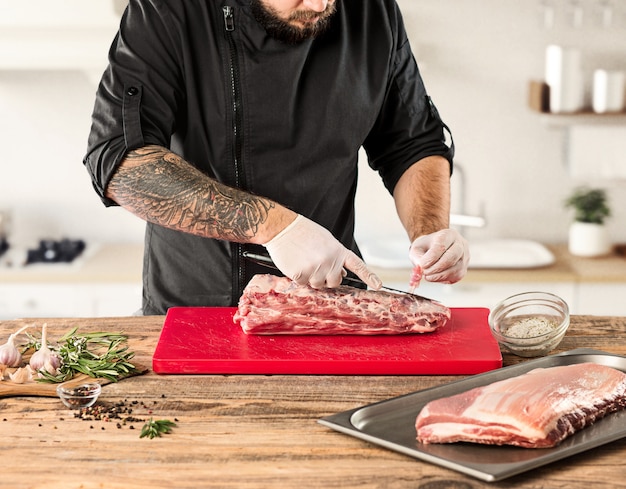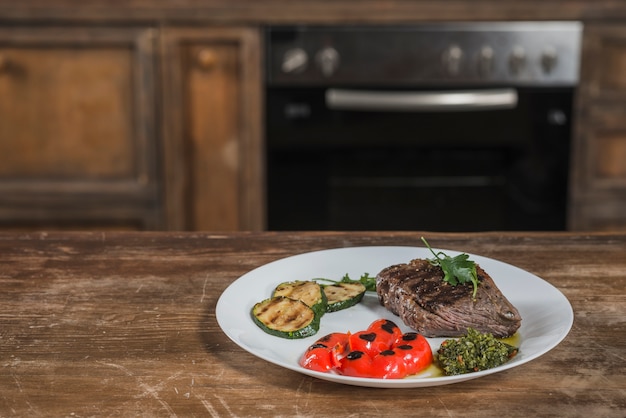As a seasoned cook who's spent countless hours in the kitchen, I've come to realize that the art of cooking a steak goes beyond just throwing it on the pan and hoping for the best. It's about understanding the science behind doneness, mastering the art of temperature control, and embracing the magic of resting. And for those who crave that consistent, perfectly cooked steak, the oven is your trusty ally. Today, I'm sharing my personal guide to oven-baked steak, a journey that'll take you from novice to steak connoisseur. Get ready to elevate your cooking game with juicy, flavorful perfection.
Part 1: Demystifying steak doneness: The Science of Temperature

Before we delve into the nitty-gritty of oven baking, let's unpack the concept of steak doneness. It's not just about the time you spend cooking; it's about the internal temperature of the steak. Each level of doneness has a specific temperature range, and mastering this crucial aspect will elevate your steak game significantly. Think of it like a temperature map, guiding you towards steak perfection:
Doneness Levels and Internal Temperatures: A Temperature Map for Your Steak
| Doneness | Internal Temperature (°F) | Internal Temperature (°C) | Texture |
|---|---|---|---|
| Rare | 125-130 | 52-54 | Cool, red center, with a slight give when pressed. |
| Medium-Rare | 130-135 | 54-57 | Slightly warmer center, still red with more resistance, offering a tender chew. |
| Medium | 135-140 | 57-60 | Warm, pink center with noticeable firmness. A balance of tenderness and chew. |
| Medium-Well | 140-145 | 60-63 | Slightly gray center, firm and chewy. A more pronounced chew. |
| Well-Done | 145 | 63 | Completely gray center, firm and dry. Most of the moisture is cooked out. |
Now, you might be thinking, "But I always cook my steak on the stovetop!" While pan-searing delivers that delicious crust, maintaining a consistent internal temperature can be tricky. The oven's even heat, like a gentle embrace, ensures that your steak cooks evenly from the inside out. This control is crucial for achieving perfect doneness, especially for thicker cuts.
Part 2: Choosing Your Weapon: The Right Cut for the Job

Not all steaks are created equal. The key to a phenomenal oven-baked steak lies in choosing the right cut. Certain cuts are naturally tender and flavorful, while others are best suited for different cooking methods. Here are some of my go-to steak choices for the oven:
Top Steak Choices for Oven Baking: A Culinary Lineup
- Ribeye: This is the king of steaks. Rich, marbled, and incredibly juicy, the ribeye is a crowd-pleaser, boasting a delightful balance of tenderness and richness. It's perfect for those who love a truly luxurious steak experience.
- new york strip: Leaner than the ribeye but still packed with bold flavor, the New York Strip offers a satisfying chew. It's a fantastic choice for those who prefer a slightly more substantial texture.
- filet mignon: For a truly melt-in-your-mouth experience, the filet mignon reigns supreme. It's the epitome of tenderness, with a delicate flavor that shines through.
- Top Sirloin: A budget-friendly option that delivers on flavor and tenderness, the top sirloin is a great choice for everyday meals. It's a versatile cut that holds its own, whether you're grilling, pan-frying, or baking it in the oven.
Feeling adventurous? Don't shy away from other cuts like flank steak or skirt steak. Remember, it's all about understanding the cooking time and temperature requirements for each cut. With a bit of research and experimentation, you can create delicious and satisfying meals using various cuts of steak.
Part 3: Prepping Your Steak for Oven Success: A Symphony of Preparation

The secret to an amazing oven steak lies in meticulous preparation. It's about ensuring an even cook, maximizing flavor, and setting the stage for a culinary masterpiece.
Patting Dry: The Essential First Step
It might seem like a minor detail, but patting your steak dry with paper towels is a crucial first step. Moisture on the surface of the steak hinders the formation of a beautiful crust, resulting in a less flavorful steak. So, before you do anything else, make sure those steaks are bone dry.
Seasoning: A Flavorful Embrace
Now, let's talk seasoning. While a simple salt and pepper combination works wonders, don't be afraid to get creative. I love adding a pinch of garlic powder, onion powder, or even smoked paprika for an extra kick. For a more complex flavor profile, try a blend of herbs like rosemary, thyme, and oregano. The key is to season generously, coating both sides of the steak evenly.
Pro Tip: Season your steak at least 30 minutes before cooking. This allows the salt to penetrate the meat, drawing out moisture and enhancing flavor.
Part 4: The Oven's Embrace: Baking Your Steak to Perfection
Now for the fun part! Oven baking your steak is simple yet elegant. It requires a few key steps to ensure optimal results and a steak that's cooked to your exact preferences. Let's get those ovens hot and those steaks sizzling!
Preheat Your Oven: Setting the Stage for Success
Always preheat your oven to the desired temperature before placing your steak. This ensures consistent heat distribution, leading to even cooking throughout. I usually preheat my oven to 400°F (200°C) for a good sear. However, if you prefer a more gentle cook, you can reduce the temperature to 350°F (175°C).
Baking Time: A Guide to Cooking Time
The baking time will vary depending on the thickness of your steak and your desired doneness. As a general rule of thumb:
- Thin steaks (1-inch): 8-10 minutes per side
- Medium steaks (1.5-2 inches): 10-12 minutes per side
- Thick steaks (over 2 inches): 15-20 minutes per side
Remember, these are just guidelines. Time is not the most accurate measure of doneness. The internal temperature is your true indicator of perfect steak. Always use a meat thermometer to ensure accuracy and avoid overcooking.
Part 5: The Art of Resting: Unlocking Tenderness and Flavor
This is a step that many overlook, but it's crucial for a truly amazing steak. After you take your steak out of the oven, let it rest for 5-10 minutes before slicing into it. Why? Here's the science behind this important step:
Resting Redistributes Juices: The Key to Tenderness
When you cook a steak, the juices within the meat move towards the center. Resting allows those juices to redistribute evenly throughout the steak, resulting in a more tender and flavorful experience. Imagine the juices as tiny treasure chests, containing the essence of flavor. Resting lets those treasure chests release their riches throughout the entire steak. This is why you often see chefs tent their steaks with foil after cooking. It helps retain heat and moisture during the resting period, ensuring a juicy and flavorful steak.
Part 6: Your Culinary Compass: The Importance of the Meat Thermometer
Here's where I get really serious. A meat thermometer is the single most important tool for achieving perfect steak doneness. It eliminates guesswork and ensures your steak is cooked to your exact preference. It's like a culinary compass, guiding you towards the perfect internal temperature.
Choosing the Right Meat Thermometer: Your Culinary Ally
There are various types of meat thermometers available, from digital probes to instant-read models. I personally prefer a digital probe thermometer, as it allows me to monitor the internal temperature continuously, giving me a real-time view of the steak's journey to perfection.
How to Use a Meat Thermometer: Mastering the Technique
Insert the thermometer into the thickest part of the steak, making sure it doesn't touch any bone. Wait until the temperature stabilizes, and then compare it to the chart in Part 1. Once your steak reaches the desired temperature, it's time to take it out of the oven and let it rest. Remember, the meat thermometer is your best friend; don't be afraid to use it!
Part 7: Elevating Your Steak Game: Sauces that Transform Your Meal
Now that you've mastered the basics of oven-baking a steak, let's add a touch of culinary magic with some delectable sauces. Sauces can transform a simple steak into a truly unforgettable dish. Think of them as the final brushstrokes on a masterpiece, adding depth, complexity, and a symphony of flavors.
Classic Sauce Pairings: A Symphony of Flavors
- Béarnaise Sauce: A rich and creamy sauce with a hint of tanginess, Béarnaise pairs perfectly with filet mignon. Its delicate flavor complements the tenderness of the filet, creating a harmonious marriage of taste and texture.
- Mushroom Sauce: A savory and earthy sauce, mushroom sauce is an excellent complement to ribeye and New York Strip. The richness of the mushrooms complements the marbled fat of the ribeye and the bold flavor of the New York Strip, adding a layer of complexity to the dish.
- Peppercorn Sauce: A bold and spicy sauce, peppercorn sauce adds a punch of flavor to any steak. The peppery kick cuts through the richness of the meat, providing a contrasting yet complementary experience.
Experiment with Flavors: Unleashing Your Culinary Creativity
Don't be afraid to get creative with your sauce choices! Try a red wine reduction, a chimichurri sauce, or even a simple pan sauce made with butter and garlic. The possibilities are endless! Remember, sauces are your culinary canvas; use them to express your creativity and add your personal touch to your steak masterpiece.
Part 8: Serving Your Steak Masterpiece: A Culinary Presentation
The final step! Serving your steak masterpiece is as much about presentation as it is about taste. Make it a memorable experience for your guests, showcasing your culinary artistry. Think of this as the grand finale, where you unveil the culmination of your efforts.
Presentation Tips: Elevating the Visual Experience
- Plate with Style: Use a beautiful serving platter or individual plates to showcase your steak. The right plate can elevate the visual appeal, making the steak the star of the show.
- Garnish for Visual Appeal: Add a sprig of rosemary, a few slices of lemon, or a drizzle of olive oil for a touch of elegance. These small touches can add a dash of color and visual interest, enhancing the overall presentation.
- Sides to Complement: Choose side dishes that complement your steak, such as roasted vegetables, creamy mashed potatoes, or a light salad. Think about creating a balance of flavors and textures, adding a symphony of culinary notes to your meal.
Remember, the key is to create a harmonious combination of flavors and textures that will tantalize your guests' taste buds. And don't forget to enjoy the fruits of your labor! A perfectly cooked oven steak is a testament to your culinary skills. Take a moment to appreciate the journey you've taken, from understanding the science to mastering the techniques. It's a journey that's worth savoring.
Part 9: FAQs: Addressing Your Burning Steak Questions
Now, I know you might have a few burning questions about your oven steak journey. Here are some of the most common ones, along with my expert answers:
1. Can I bake frozen steak?
It's not recommended to bake frozen steak. The uneven thawing can lead to inconsistent cooking and a tough steak. Always defrost your steak in the refrigerator overnight to ensure proper results. Think of it like giving your steak a chance to thaw gently and evenly, ensuring a more consistent cook.
2. What if I don't have a meat thermometer?
While a meat thermometer is the most accurate way to determine doneness, you can use the "touch" method as a guide. Press gently on the center of the steak:
- Rare: The steak will feel soft and cool to the touch.
- Medium-Rare: The steak will feel slightly firm and warm.
- Medium: The steak will feel firm and warm.
- Medium-Well: The steak will feel firm and hot.
- Well-Done: The steak will feel firm and very hot.
However, this method is less precise than using a thermometer, so it's best to err on the side of caution and cook your steak a little less than you think. Remember, it's always better to have a slightly undercooked steak than an overcooked one.
3. Can I bake multiple steaks at once?
Yes, you can bake multiple steaks at once, but you may need to adjust the baking time slightly. Just be sure to leave enough space between the steaks to allow for even heat distribution. If you're unsure, it's always better to err on the side of undercooking and bake for a few extra minutes. This ensures that all your steaks reach the desired doneness without overcooking any of them.
4. What if I overcook my steak?
Don't panic! Overcooked steak isn't necessarily ruined. You can try slicing it thinly and using it in a dish like stir-fry or tacos. Or, you can simply enjoy it with a flavorful sauce that can mask any dryness. It's all about being creative and finding ways to salvage a delicious meal. Remember, even mistakes in the kitchen can lead to unexpected culinary discoveries.
5. How do I store leftover steak?
Leftover steak can be stored in the refrigerator for up to 3 days. Wrap it tightly in plastic wrap or aluminum foil to prevent drying out. You can reheat it in the oven, microwave, or on the stovetop. For a more flavorful reheating experience, consider using a pan with a little butter or oil. This will help to keep the steak moist and flavorful.
There you have it! Now you're equipped with the knowledge and confidence to cook the perfect oven steak. So go forth, experiment, and impress your loved ones with your culinary mastery! Happy cooking, my friends! And remember, the journey towards a perfect steak is just as rewarding as the final bite.
Everyone is watching

How to Cook Frozen Lobster Tails Perfectly: A Step-by-Step Guide
RecipesLobster. Just the word conjures up images of lavish meals, special occasions, and a taste of luxury. But let's...

Pigs in a Blanket Cooking Time: How Long to Bake for Perfect Results
RecipesAh, pigs in a blanket. Just the name conjures up images of those delightful little parcels of crispy pastry en...

Pork Fillet Cooking Time: How Long to Cook It Perfectly
RecipesPork fillet, or tenderloin as it's sometimes called, is a real favourite in our house. It's so versatile, and...

The Ultimate Guide to Cooking Delicious Frankfurters
RecipesLet's face it, we all love a good frankfurter. It's a classic, simple, and always satisfying. But let's be rea...

Wolf Meat Recipes: A Guide to Cooking Wild Game
RecipesLet's be honest, you don't see wolf meat at your local butcher shop every day. It's a bit of a wild card, but ...
